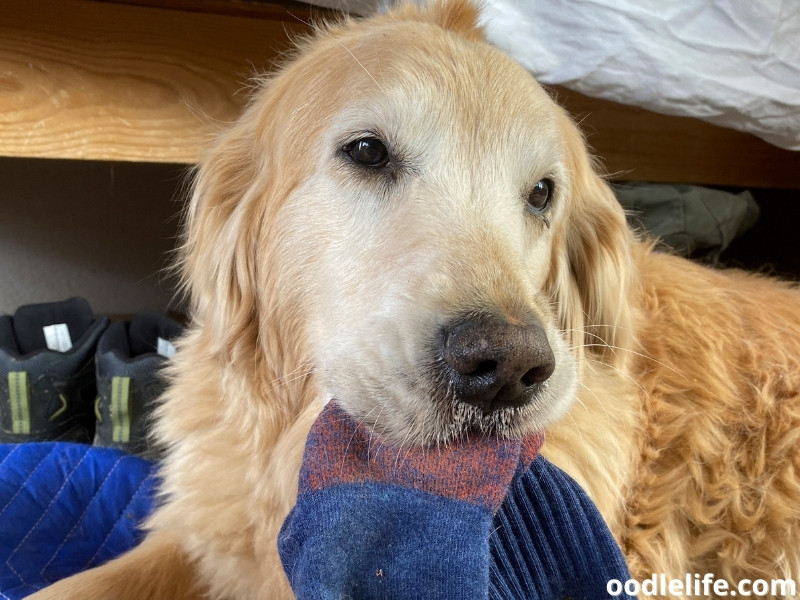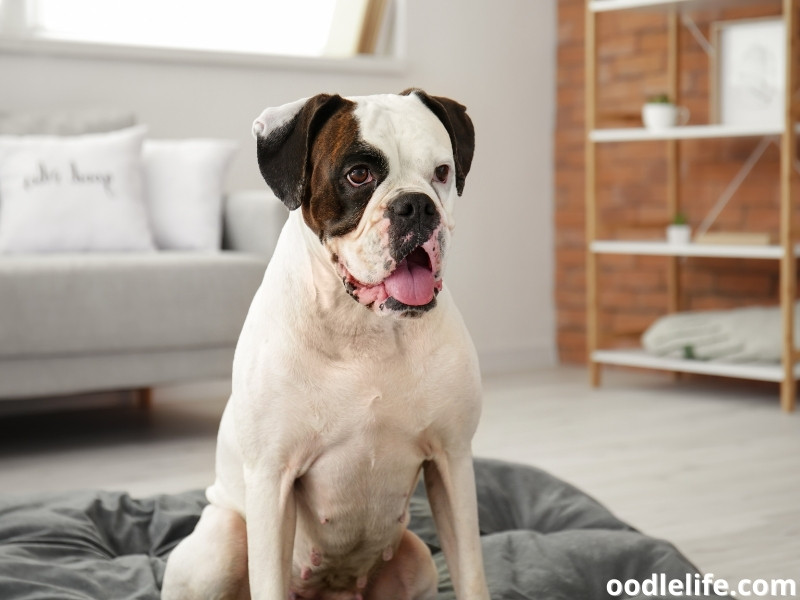Why Do Dogs Nest? [Nesting Explained]
If you thought nesting was only for birds, your dog might be making you rethink this theory. So, if you’re wondering, “Why do dogs nest?” I’ll share the most common—and unexpected—reasons here.
Dogs nest for various reasons, including because they’re pregnant, think they’re pregnant, want to feel secure, and for comfort.

As you’ll soon learn, nesting is normal and rarely a reason for medical concern.
Defining the Term “Nesting”
Nesting is the concept of a dog creating a place to rest. It’s more common in females than males for pregnancy reasons, but dogs of either gender can nest.
People have different views of what nesting entails. But generally speaking, it can look like one or more of the following:
- Burrowing
- Toy collecting
- Shredding bedding
- Excessive grooming
- Defending their nesting area
- Rearranging blankets or beds
Generally speaking, female dogs are the ones that will start defending their nesting area or groom excessively if they’re pregnant or believe they’re pregnant.
But in most cases, you don’t have to worry about approaching your dog when they nest—it’s a common practice, and as long as they’re not pregnant, having you at their side as they do their nesting will likely make them even happier.

The Biological Reason for Nesting
According to researchers, female dogs show nesting behaviors before parturition and from birth up until ten weeks after having their babies. However, the degree to which females nest appears to depend on external factors as well, including the degree of human contact they’re used to.
You may notice your nesting female dog shredding cloth, paper, and other items in an attempt to make their nest. Such behaviors typically happen as uterine contractions increase in frequency and intensity.
The reason why nesting is so crucial for pregnant dogs is that puppies aren’t able to regulate their body temperatures when they’re born. Therefore, building a well-made nest will hold heat when the puppies aren’t in direct contact with their mother’s body.
It isn’t until puppies turn around three weeks old that they leave their nest for the first time and start exploring independently.

Other Reasons for Nesting
So, now that you know there’s a biological reason why dogs nest, you might be looking at your male or spayed female dog and wondering—why do dogs nest when they’re not pregnant?
The cause often comes down to three main reasons:
1. Creates a Feeling of Security
All beings want to feel secure, and nesting is a way for dogs to fill this need. Just like humans love getting into bed after a stressful day, dogs use nesting to create a sense of security, knowing that nothing bad will happen to them there.
Nesting dates back to a dog’s wolf ancestors. Wolves create dens in south-facing and well-draining soil by digging a hole as large as 40 inches deep and 50 inches wide. They often search for a place to dig under a large rock, between tree roots, or hollow logs.
For this reason, it stands to reason that dogs enjoy the comfort of a small, dark crate, as it mimics the comfort of a den.
However, unlike dogs, wolves don’t use bedding or toys in their nesting areas to build a sense of security. If you’re looking at your dog right now laughing about their pampered ways, I did, too, when I learned this.

2. It’s Comfortable
Obviously, there’s no need for your dog to dig at your hardwood living room floor or fluff up their already fluffy bed in order to feel comfortable. But it’s a well-accepted theory that non-pregnant dogs nest to make themselves comfortable.
Yet again, the reason comes down to your dog’s ancestors.
Since wild dogs didn’t have the comforts of modern-day dogs, they would nest to create a comfortable place to sleep. That’s why your dog circles before lying down in the nest they made as well.
Back in the day, dogs would circle to pat down brush in the woods and tall grass to create a more comfortable sleeping and birthing place. Scientists also believe there’s a safety factor in addition to comfort, as it would scare away snakes and insects that could harm them.
In either case, it’s challenging to get your dog to stop nesting and circling before they settle in for a nap, and you should never try to stop this instinctual behavior as long as they’re not tearing up your furniture in the process.

3. A Female Dog Believes They’re Pregnant
One of the most interesting answers to the question “Why do dogs nest?” is that it could be because a female dog believes she’s pregnant even when she’s most definitely not. That can include spayed females.
Before calling your dog crazy, though, know that the same can happen in humans. Pseudocyesis is a condition where a woman displays pregnancy symptoms even when she’s not. Symptoms can include breast enlargement, morning sickness, abdominal distention, and weight gain.
In the case of dogs, females may show signs of false pregnancy nesting around 6 – 8 months after their last heat.
Veterinarians still know little about this phenomenon. However, since spayed female dogs can still mate, there’s the theory that a female dog can believe she’s pregnant. Therefore, she’ll start showing signs of nesting when she, in theory, should be getting ready to have her babies after being in heat.
Other experts suggest that there could be a medical condition that causes a female dog to believe she’s pregnant. However, unless your dog shows signs of pain or illness, you likely don’t need to take them to the vet.
If you have an unspayed female dog, then signs of an actual pregnancy include enlarged mammary glands and weight gain.

Helping Your Dog Find a Suitable Nest
Because dogs have a natural desire to nest, it’s best to offer them suitable nesting spaces. “Suitable” will look different depending on whether your dog is pregnant.
Pregnant females will need a quiet, isolated place to do their nesting. Make sure it’s in an area of your home where you don’t mind her digging at the floor and where she’s not sharing a wall with a sleeping human baby, for her natural instinct will be to borrow and howl.
These behaviors are completely normal, and it’s crucial to let your mamma dog do her thing.
If your dog isn’t pregnant, then a crate is one of the best nesting options to present to her. Your dog will appreciate a dark, quiet space, especially if you put a piece of clothing in the crate with your scent on it.
The key is to strike a balance between the crate being large enough for your dog to stand and circle around but not so big that it encourages them to defecate there.

So, Should You Be Worried About Nesting?
In almost all cases, there’s no need to be worried about your dog’s nesting behaviors. You shouldn’t ever reprimand your dog for nesting, either. How would you like it if someone yelled at you for fluffing your pillow?
I know that nesting can sometimes feel overwhelming, especially if your dog has nesting behaviors that involve shredding their bedding. In that case, you might want to enlist the help of a dog trainer who can teach you positive reinforcement techniques to manage the way your dog nests.
Of course, if you notice that your dog is suddenly showing signs of nesting and displaying other strange behaviors, it’s best to take them to the vet.